Leadership and Change Management Report - Royal Lancaster Hotel
VerifiedAdded on 2023/01/19
|23
|4509
|92
Report
AI Summary
This report analyzes the leadership styles and change management strategies implemented at the Royal Lancaster London Hotel. It begins by evaluating the appropriateness of different leadership styles, including autocratic, democratic, laissez-faire, and transformational approaches, in managing organizational change. The report then assesses the effectiveness of these styles within the hotel's organizational lifecycle, utilizing the Sigmoid Curve model to determine the current stage of development. Furthermore, the study identifies key stakeholders and potential resistance to change, exploring the reasons behind this resistance and proposing effective communication strategies to mitigate it before, during, and after the change process. The findings highlight the efficiency of the adopted leadership style, while also acknowledging the need for more effective change management practices, particularly at the middle and lower management levels. The report concludes with recommendations for improving change management procedures within the hotel.
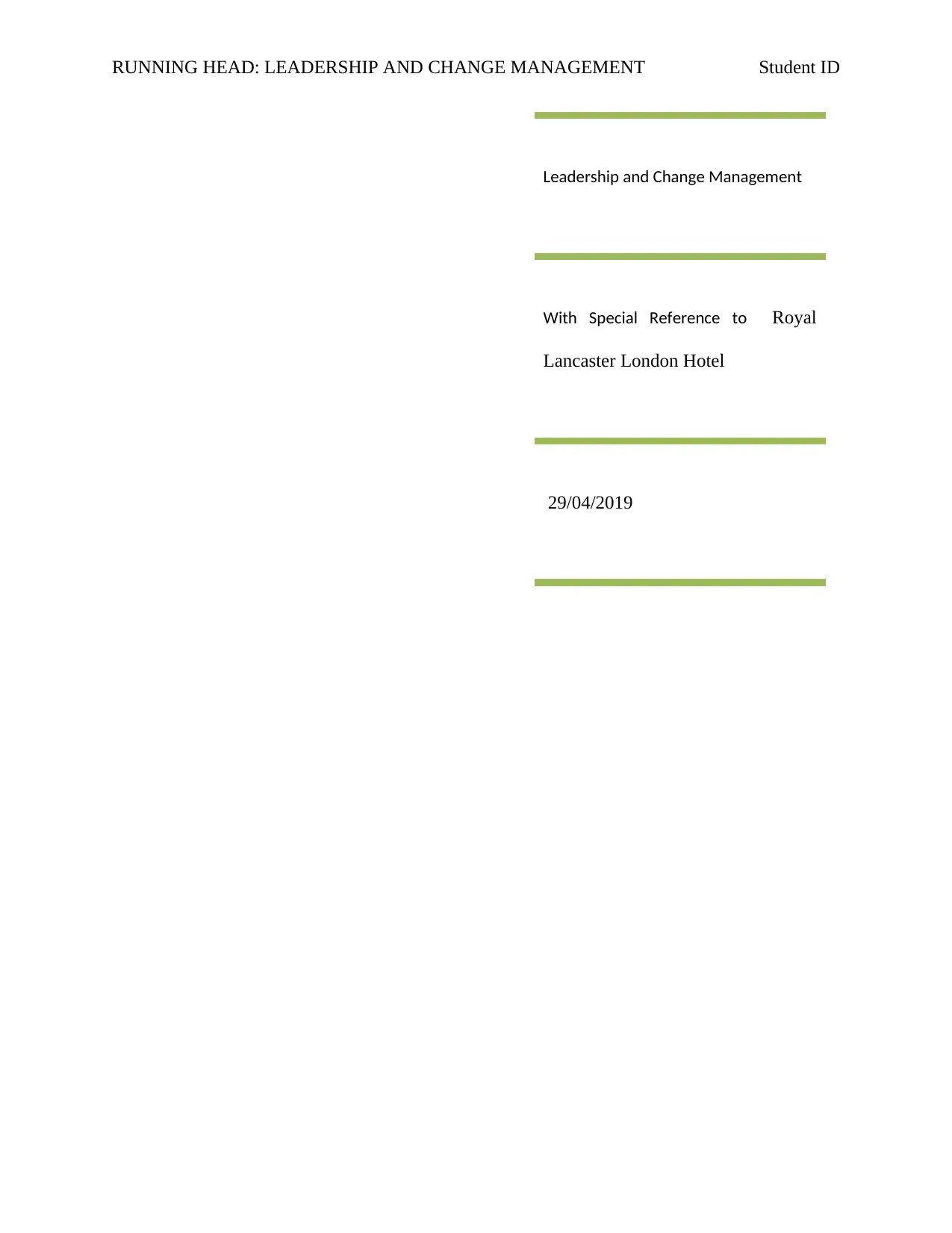
RUNNING HEAD: LEADERSHIP AND CHANGE MANAGEMENT Student ID
Leadership and Change Management
With Special Reference to Royal
Lancaster London Hotel
29/04/2019
Leadership and Change Management
With Special Reference to Royal
Lancaster London Hotel
29/04/2019
Paraphrase This Document
Need a fresh take? Get an instant paraphrase of this document with our AI Paraphraser
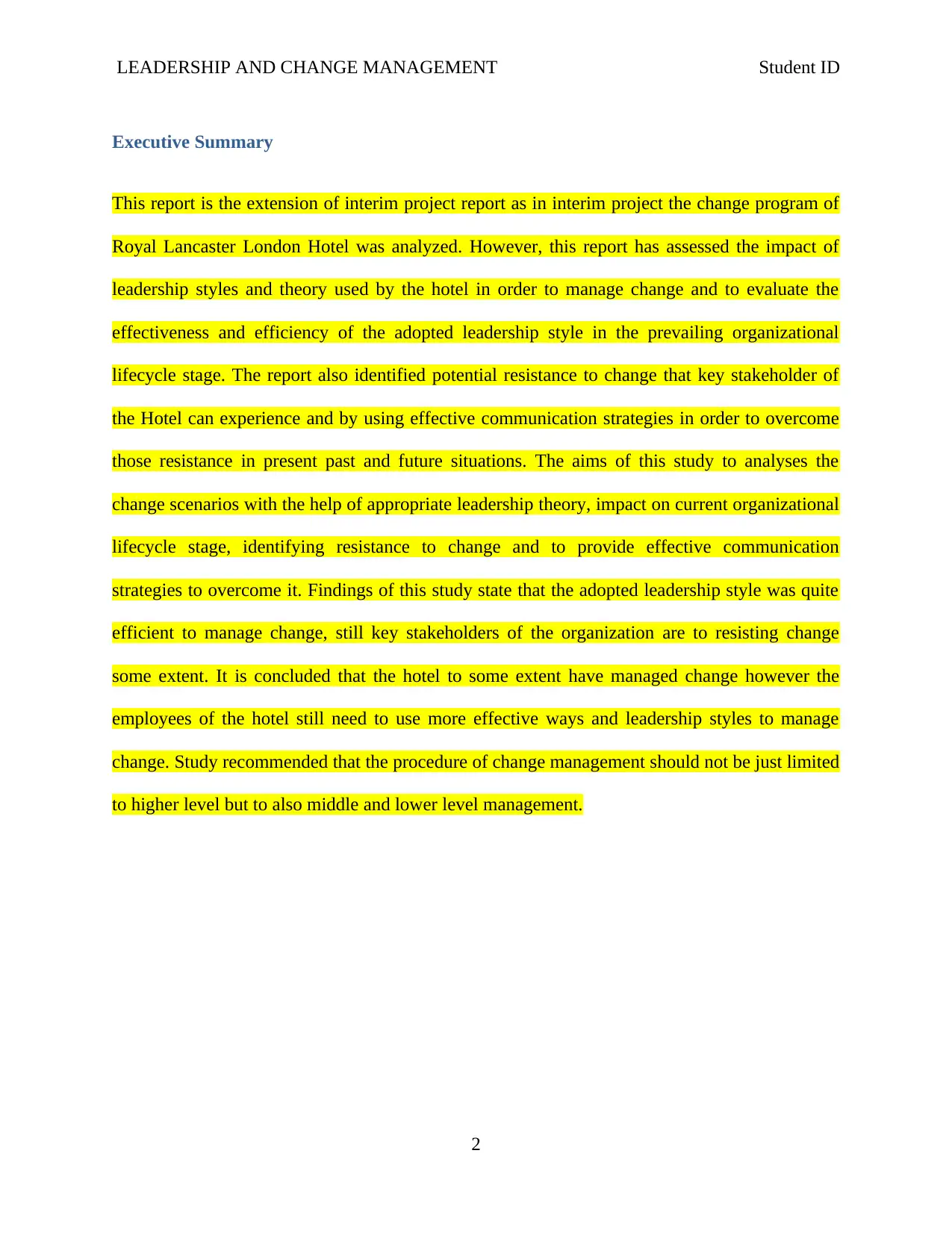
LEADERSHIP AND CHANGE MANAGEMENT Student ID
Executive Summary
This report is the extension of interim project report as in interim project the change program of
Royal Lancaster London Hotel was analyzed. However, this report has assessed the impact of
leadership styles and theory used by the hotel in order to manage change and to evaluate the
effectiveness and efficiency of the adopted leadership style in the prevailing organizational
lifecycle stage. The report also identified potential resistance to change that key stakeholder of
the Hotel can experience and by using effective communication strategies in order to overcome
those resistance in present past and future situations. The aims of this study to analyses the
change scenarios with the help of appropriate leadership theory, impact on current organizational
lifecycle stage, identifying resistance to change and to provide effective communication
strategies to overcome it. Findings of this study state that the adopted leadership style was quite
efficient to manage change, still key stakeholders of the organization are to resisting change
some extent. It is concluded that the hotel to some extent have managed change however the
employees of the hotel still need to use more effective ways and leadership styles to manage
change. Study recommended that the procedure of change management should not be just limited
to higher level but to also middle and lower level management.
2
Executive Summary
This report is the extension of interim project report as in interim project the change program of
Royal Lancaster London Hotel was analyzed. However, this report has assessed the impact of
leadership styles and theory used by the hotel in order to manage change and to evaluate the
effectiveness and efficiency of the adopted leadership style in the prevailing organizational
lifecycle stage. The report also identified potential resistance to change that key stakeholder of
the Hotel can experience and by using effective communication strategies in order to overcome
those resistance in present past and future situations. The aims of this study to analyses the
change scenarios with the help of appropriate leadership theory, impact on current organizational
lifecycle stage, identifying resistance to change and to provide effective communication
strategies to overcome it. Findings of this study state that the adopted leadership style was quite
efficient to manage change, still key stakeholders of the organization are to resisting change
some extent. It is concluded that the hotel to some extent have managed change however the
employees of the hotel still need to use more effective ways and leadership styles to manage
change. Study recommended that the procedure of change management should not be just limited
to higher level but to also middle and lower level management.
2
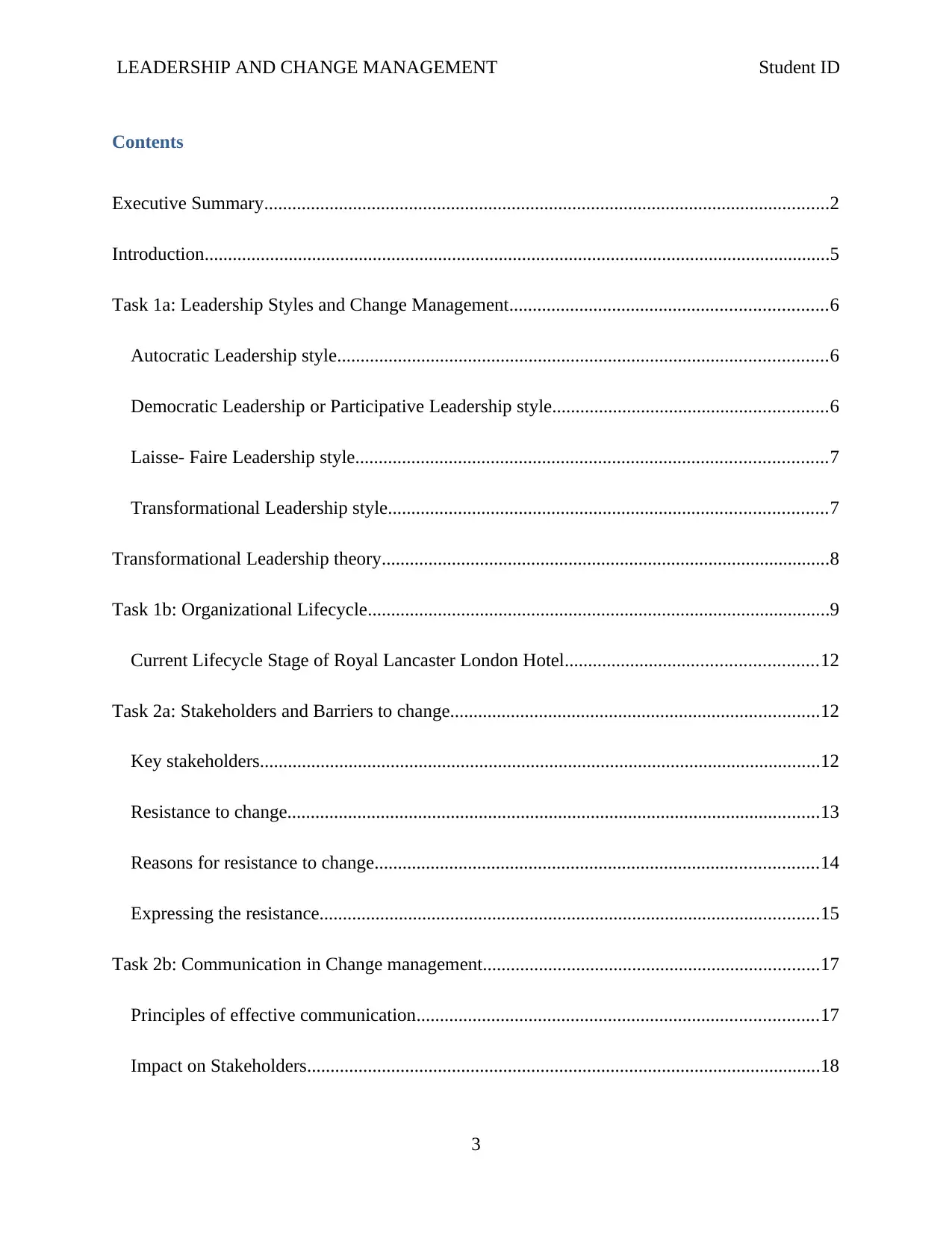
LEADERSHIP AND CHANGE MANAGEMENT Student ID
Contents
Executive Summary.........................................................................................................................2
Introduction......................................................................................................................................5
Task 1a: Leadership Styles and Change Management....................................................................6
Autocratic Leadership style.........................................................................................................6
Democratic Leadership or Participative Leadership style...........................................................6
Laisse- Faire Leadership style.....................................................................................................7
Transformational Leadership style..............................................................................................7
Transformational Leadership theory................................................................................................8
Task 1b: Organizational Lifecycle...................................................................................................9
Current Lifecycle Stage of Royal Lancaster London Hotel......................................................12
Task 2a: Stakeholders and Barriers to change...............................................................................12
Key stakeholders........................................................................................................................12
Resistance to change..................................................................................................................13
Reasons for resistance to change...............................................................................................14
Expressing the resistance...........................................................................................................15
Task 2b: Communication in Change management........................................................................17
Principles of effective communication......................................................................................17
Impact on Stakeholders..............................................................................................................18
3
Contents
Executive Summary.........................................................................................................................2
Introduction......................................................................................................................................5
Task 1a: Leadership Styles and Change Management....................................................................6
Autocratic Leadership style.........................................................................................................6
Democratic Leadership or Participative Leadership style...........................................................6
Laisse- Faire Leadership style.....................................................................................................7
Transformational Leadership style..............................................................................................7
Transformational Leadership theory................................................................................................8
Task 1b: Organizational Lifecycle...................................................................................................9
Current Lifecycle Stage of Royal Lancaster London Hotel......................................................12
Task 2a: Stakeholders and Barriers to change...............................................................................12
Key stakeholders........................................................................................................................12
Resistance to change..................................................................................................................13
Reasons for resistance to change...............................................................................................14
Expressing the resistance...........................................................................................................15
Task 2b: Communication in Change management........................................................................17
Principles of effective communication......................................................................................17
Impact on Stakeholders..............................................................................................................18
3
⊘ This is a preview!⊘
Do you want full access?
Subscribe today to unlock all pages.

Trusted by 1+ million students worldwide
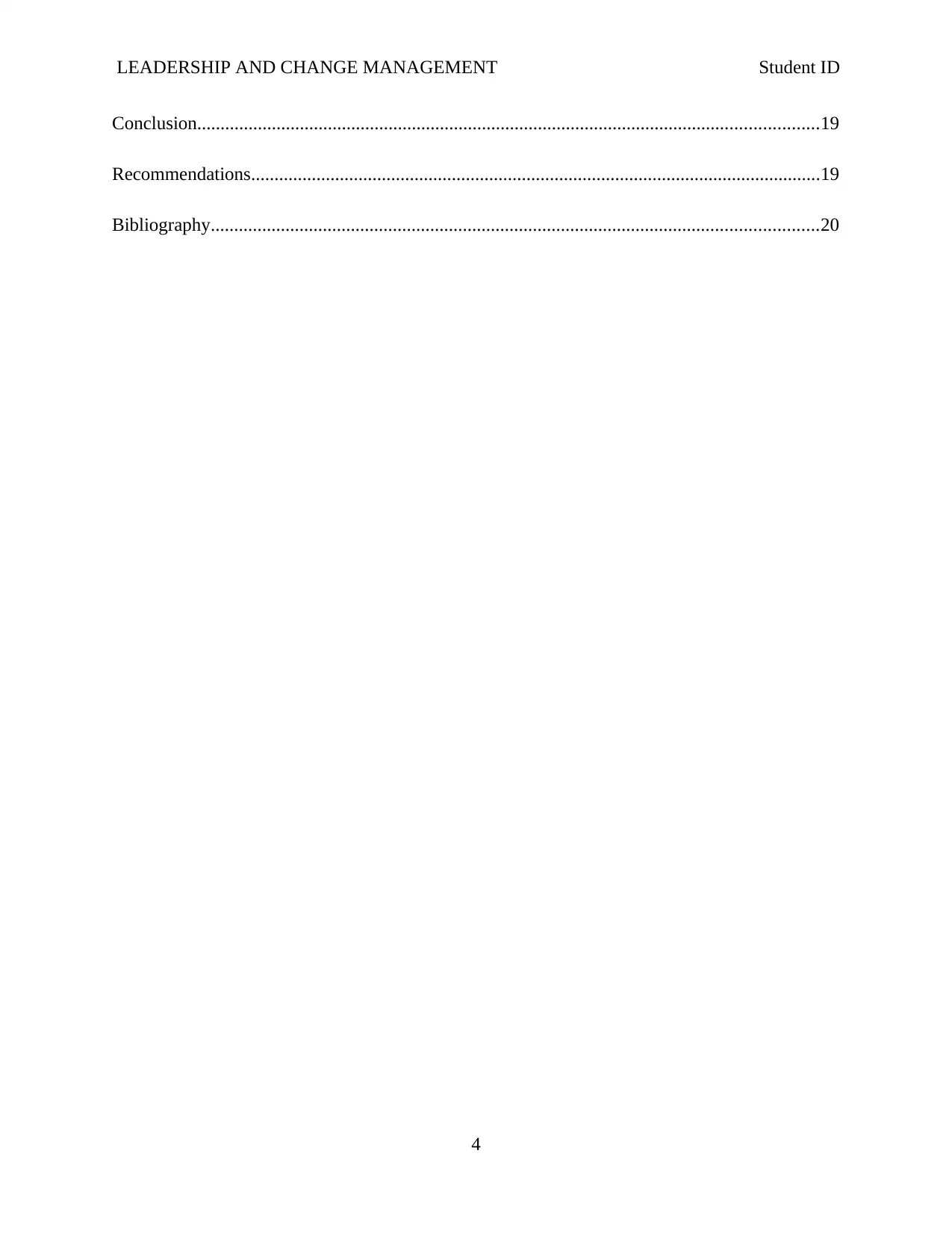
LEADERSHIP AND CHANGE MANAGEMENT Student ID
Conclusion.....................................................................................................................................19
Recommendations..........................................................................................................................19
Bibliography..................................................................................................................................20
4
Conclusion.....................................................................................................................................19
Recommendations..........................................................................................................................19
Bibliography..................................................................................................................................20
4
Paraphrase This Document
Need a fresh take? Get an instant paraphrase of this document with our AI Paraphraser
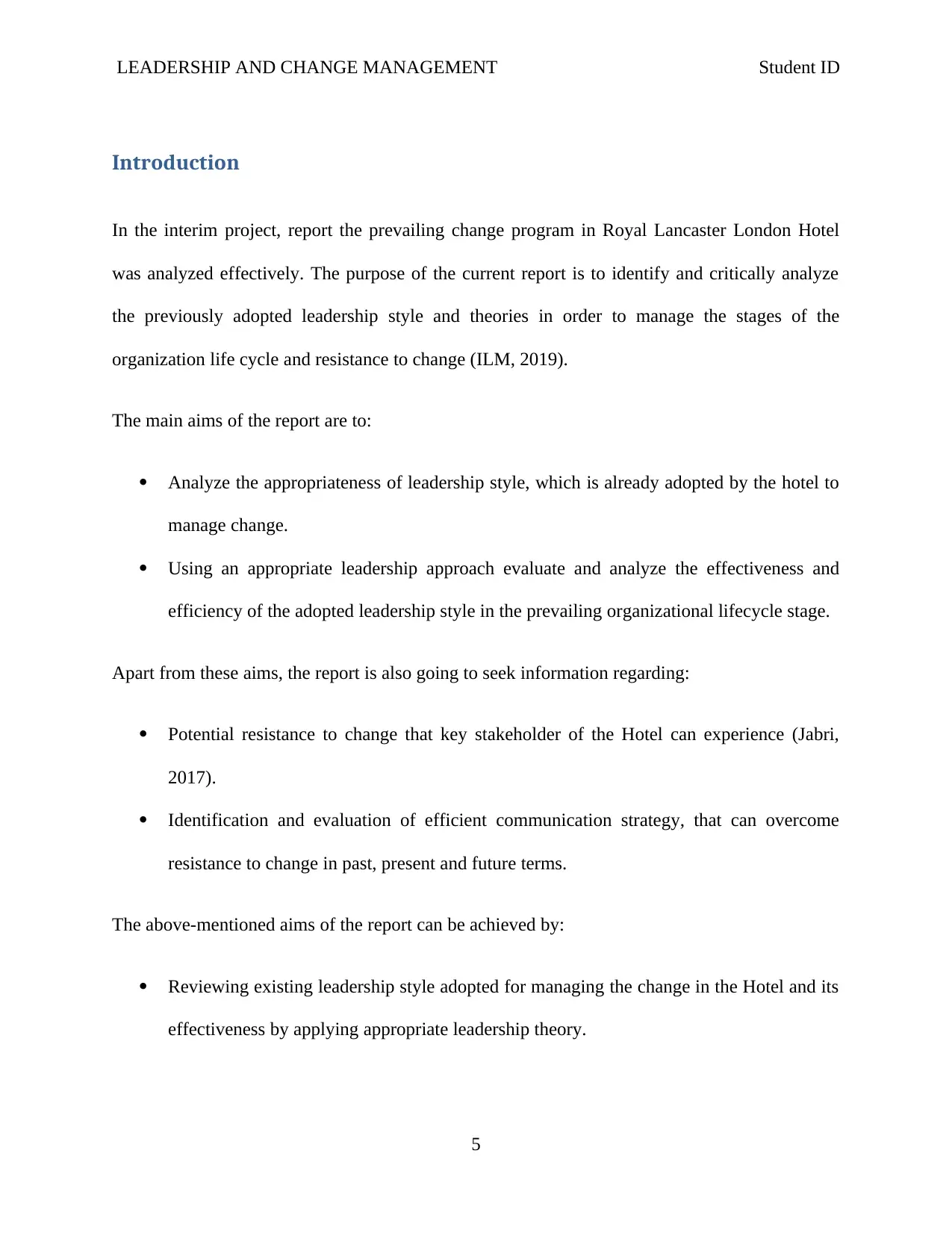
LEADERSHIP AND CHANGE MANAGEMENT Student ID
Introduction
In the interim project, report the prevailing change program in Royal Lancaster London Hotel
was analyzed effectively. The purpose of the current report is to identify and critically analyze
the previously adopted leadership style and theories in order to manage the stages of the
organization life cycle and resistance to change (ILM, 2019).
The main aims of the report are to:
Analyze the appropriateness of leadership style, which is already adopted by the hotel to
manage change.
Using an appropriate leadership approach evaluate and analyze the effectiveness and
efficiency of the adopted leadership style in the prevailing organizational lifecycle stage.
Apart from these aims, the report is also going to seek information regarding:
Potential resistance to change that key stakeholder of the Hotel can experience (Jabri,
2017).
Identification and evaluation of efficient communication strategy, that can overcome
resistance to change in past, present and future terms.
The above-mentioned aims of the report can be achieved by:
Reviewing existing leadership style adopted for managing the change in the Hotel and its
effectiveness by applying appropriate leadership theory.
5
Introduction
In the interim project, report the prevailing change program in Royal Lancaster London Hotel
was analyzed effectively. The purpose of the current report is to identify and critically analyze
the previously adopted leadership style and theories in order to manage the stages of the
organization life cycle and resistance to change (ILM, 2019).
The main aims of the report are to:
Analyze the appropriateness of leadership style, which is already adopted by the hotel to
manage change.
Using an appropriate leadership approach evaluate and analyze the effectiveness and
efficiency of the adopted leadership style in the prevailing organizational lifecycle stage.
Apart from these aims, the report is also going to seek information regarding:
Potential resistance to change that key stakeholder of the Hotel can experience (Jabri,
2017).
Identification and evaluation of efficient communication strategy, that can overcome
resistance to change in past, present and future terms.
The above-mentioned aims of the report can be achieved by:
Reviewing existing leadership style adopted for managing the change in the Hotel and its
effectiveness by applying appropriate leadership theory.
5
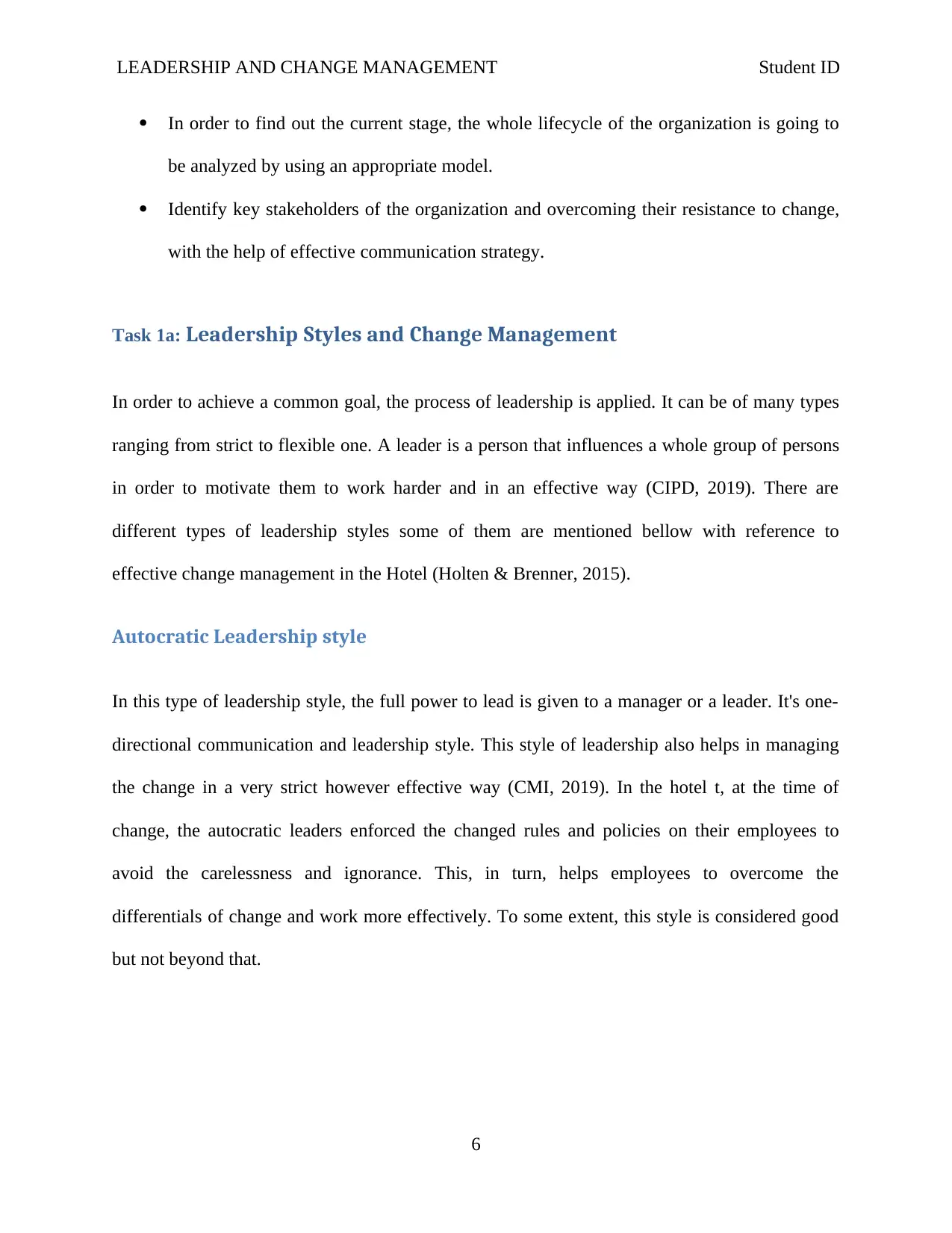
LEADERSHIP AND CHANGE MANAGEMENT Student ID
In order to find out the current stage, the whole lifecycle of the organization is going to
be analyzed by using an appropriate model.
Identify key stakeholders of the organization and overcoming their resistance to change,
with the help of effective communication strategy.
Task 1a: Leadership Styles and Change Management
In order to achieve a common goal, the process of leadership is applied. It can be of many types
ranging from strict to flexible one. A leader is a person that influences a whole group of persons
in order to motivate them to work harder and in an effective way (CIPD, 2019). There are
different types of leadership styles some of them are mentioned bellow with reference to
effective change management in the Hotel (Holten & Brenner, 2015).
Autocratic Leadership style
In this type of leadership style, the full power to lead is given to a manager or a leader. It's one-
directional communication and leadership style. This style of leadership also helps in managing
the change in a very strict however effective way (CMI, 2019). In the hotel t, at the time of
change, the autocratic leaders enforced the changed rules and policies on their employees to
avoid the carelessness and ignorance. This, in turn, helps employees to overcome the
differentials of change and work more effectively. To some extent, this style is considered good
but not beyond that.
6
In order to find out the current stage, the whole lifecycle of the organization is going to
be analyzed by using an appropriate model.
Identify key stakeholders of the organization and overcoming their resistance to change,
with the help of effective communication strategy.
Task 1a: Leadership Styles and Change Management
In order to achieve a common goal, the process of leadership is applied. It can be of many types
ranging from strict to flexible one. A leader is a person that influences a whole group of persons
in order to motivate them to work harder and in an effective way (CIPD, 2019). There are
different types of leadership styles some of them are mentioned bellow with reference to
effective change management in the Hotel (Holten & Brenner, 2015).
Autocratic Leadership style
In this type of leadership style, the full power to lead is given to a manager or a leader. It's one-
directional communication and leadership style. This style of leadership also helps in managing
the change in a very strict however effective way (CMI, 2019). In the hotel t, at the time of
change, the autocratic leaders enforced the changed rules and policies on their employees to
avoid the carelessness and ignorance. This, in turn, helps employees to overcome the
differentials of change and work more effectively. To some extent, this style is considered good
but not beyond that.
6
⊘ This is a preview!⊘
Do you want full access?
Subscribe today to unlock all pages.

Trusted by 1+ million students worldwide
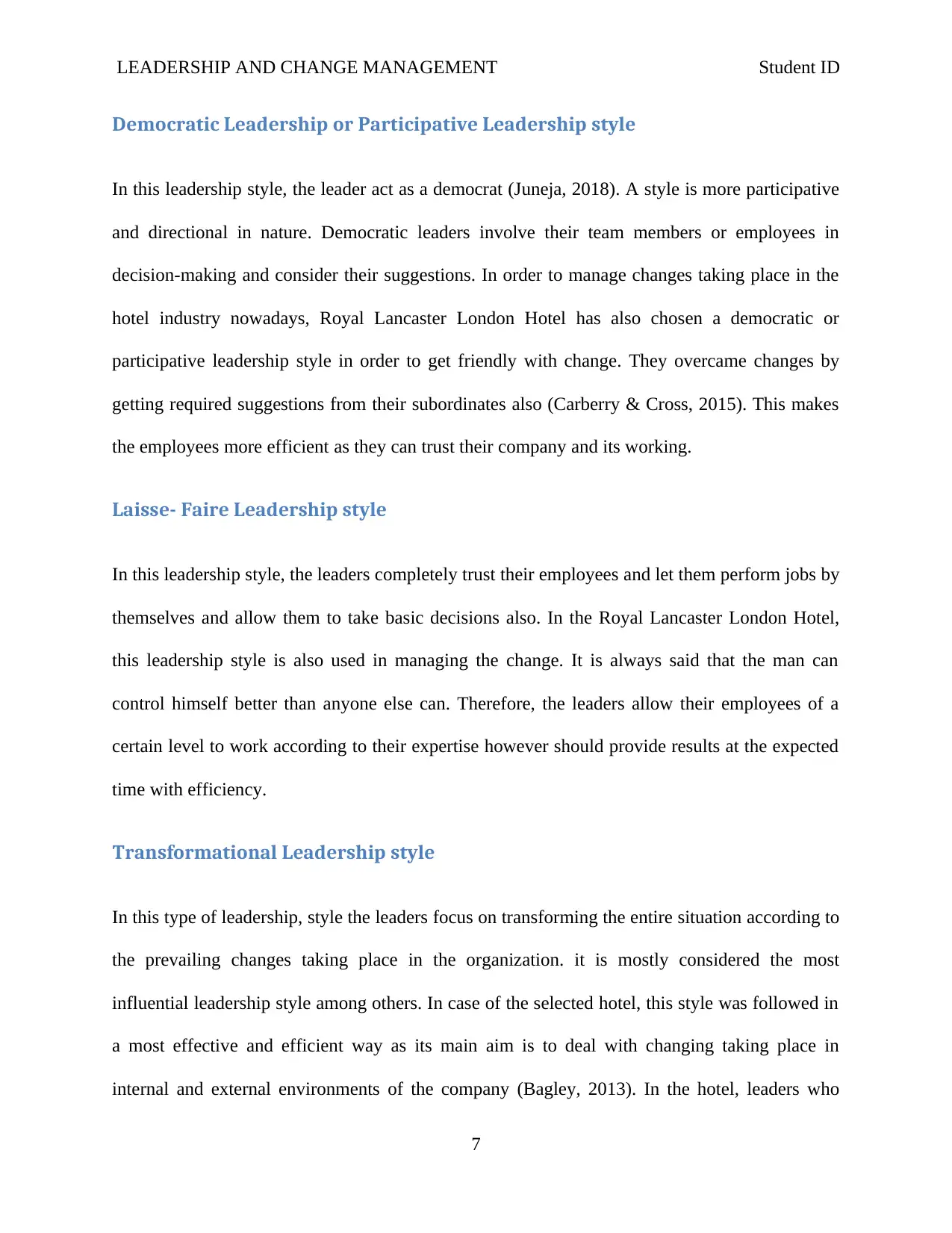
LEADERSHIP AND CHANGE MANAGEMENT Student ID
Democratic Leadership or Participative Leadership style
In this leadership style, the leader act as a democrat (Juneja, 2018). A style is more participative
and directional in nature. Democratic leaders involve their team members or employees in
decision-making and consider their suggestions. In order to manage changes taking place in the
hotel industry nowadays, Royal Lancaster London Hotel has also chosen a democratic or
participative leadership style in order to get friendly with change. They overcame changes by
getting required suggestions from their subordinates also (Carberry & Cross, 2015). This makes
the employees more efficient as they can trust their company and its working.
Laisse- Faire Leadership style
In this leadership style, the leaders completely trust their employees and let them perform jobs by
themselves and allow them to take basic decisions also. In the Royal Lancaster London Hotel,
this leadership style is also used in managing the change. It is always said that the man can
control himself better than anyone else can. Therefore, the leaders allow their employees of a
certain level to work according to their expertise however should provide results at the expected
time with efficiency.
Transformational Leadership style
In this type of leadership, style the leaders focus on transforming the entire situation according to
the prevailing changes taking place in the organization. it is mostly considered the most
influential leadership style among others. In case of the selected hotel, this style was followed in
a most effective and efficient way as its main aim is to deal with changing taking place in
internal and external environments of the company (Bagley, 2013). In the hotel, leaders who
7
Democratic Leadership or Participative Leadership style
In this leadership style, the leader act as a democrat (Juneja, 2018). A style is more participative
and directional in nature. Democratic leaders involve their team members or employees in
decision-making and consider their suggestions. In order to manage changes taking place in the
hotel industry nowadays, Royal Lancaster London Hotel has also chosen a democratic or
participative leadership style in order to get friendly with change. They overcame changes by
getting required suggestions from their subordinates also (Carberry & Cross, 2015). This makes
the employees more efficient as they can trust their company and its working.
Laisse- Faire Leadership style
In this leadership style, the leaders completely trust their employees and let them perform jobs by
themselves and allow them to take basic decisions also. In the Royal Lancaster London Hotel,
this leadership style is also used in managing the change. It is always said that the man can
control himself better than anyone else can. Therefore, the leaders allow their employees of a
certain level to work according to their expertise however should provide results at the expected
time with efficiency.
Transformational Leadership style
In this type of leadership, style the leaders focus on transforming the entire situation according to
the prevailing changes taking place in the organization. it is mostly considered the most
influential leadership style among others. In case of the selected hotel, this style was followed in
a most effective and efficient way as its main aim is to deal with changing taking place in
internal and external environments of the company (Bagley, 2013). In the hotel, leaders who
7
Paraphrase This Document
Need a fresh take? Get an instant paraphrase of this document with our AI Paraphraser
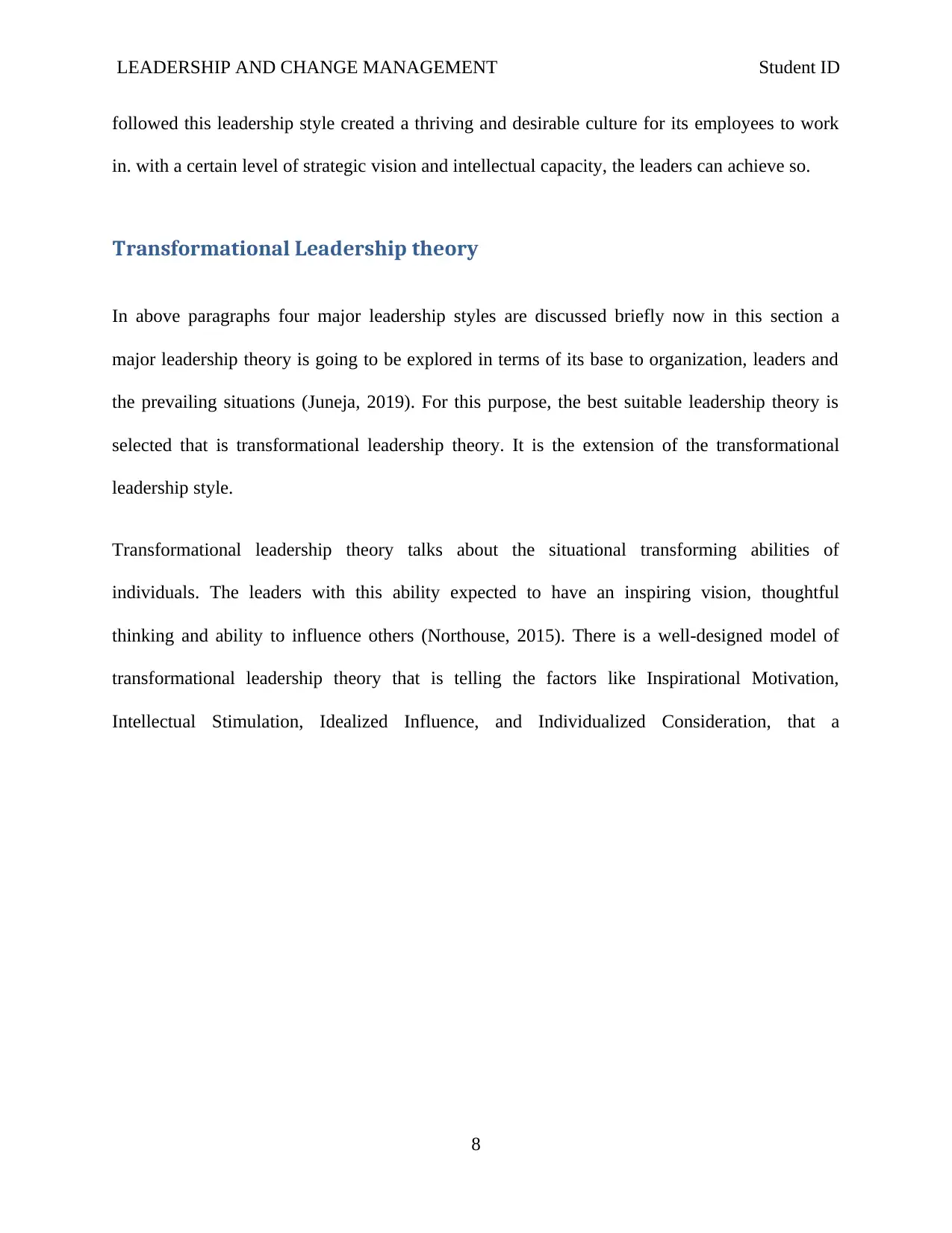
LEADERSHIP AND CHANGE MANAGEMENT Student ID
followed this leadership style created a thriving and desirable culture for its employees to work
in. with a certain level of strategic vision and intellectual capacity, the leaders can achieve so.
Transformational Leadership theory
In above paragraphs four major leadership styles are discussed briefly now in this section a
major leadership theory is going to be explored in terms of its base to organization, leaders and
the prevailing situations (Juneja, 2019). For this purpose, the best suitable leadership theory is
selected that is transformational leadership theory. It is the extension of the transformational
leadership style.
Transformational leadership theory talks about the situational transforming abilities of
individuals. The leaders with this ability expected to have an inspiring vision, thoughtful
thinking and ability to influence others (Northouse, 2015). There is a well-designed model of
transformational leadership theory that is telling the factors like Inspirational Motivation,
Intellectual Stimulation, Idealized Influence, and Individualized Consideration, that a
8
followed this leadership style created a thriving and desirable culture for its employees to work
in. with a certain level of strategic vision and intellectual capacity, the leaders can achieve so.
Transformational Leadership theory
In above paragraphs four major leadership styles are discussed briefly now in this section a
major leadership theory is going to be explored in terms of its base to organization, leaders and
the prevailing situations (Juneja, 2019). For this purpose, the best suitable leadership theory is
selected that is transformational leadership theory. It is the extension of the transformational
leadership style.
Transformational leadership theory talks about the situational transforming abilities of
individuals. The leaders with this ability expected to have an inspiring vision, thoughtful
thinking and ability to influence others (Northouse, 2015). There is a well-designed model of
transformational leadership theory that is telling the factors like Inspirational Motivation,
Intellectual Stimulation, Idealized Influence, and Individualized Consideration, that a
8
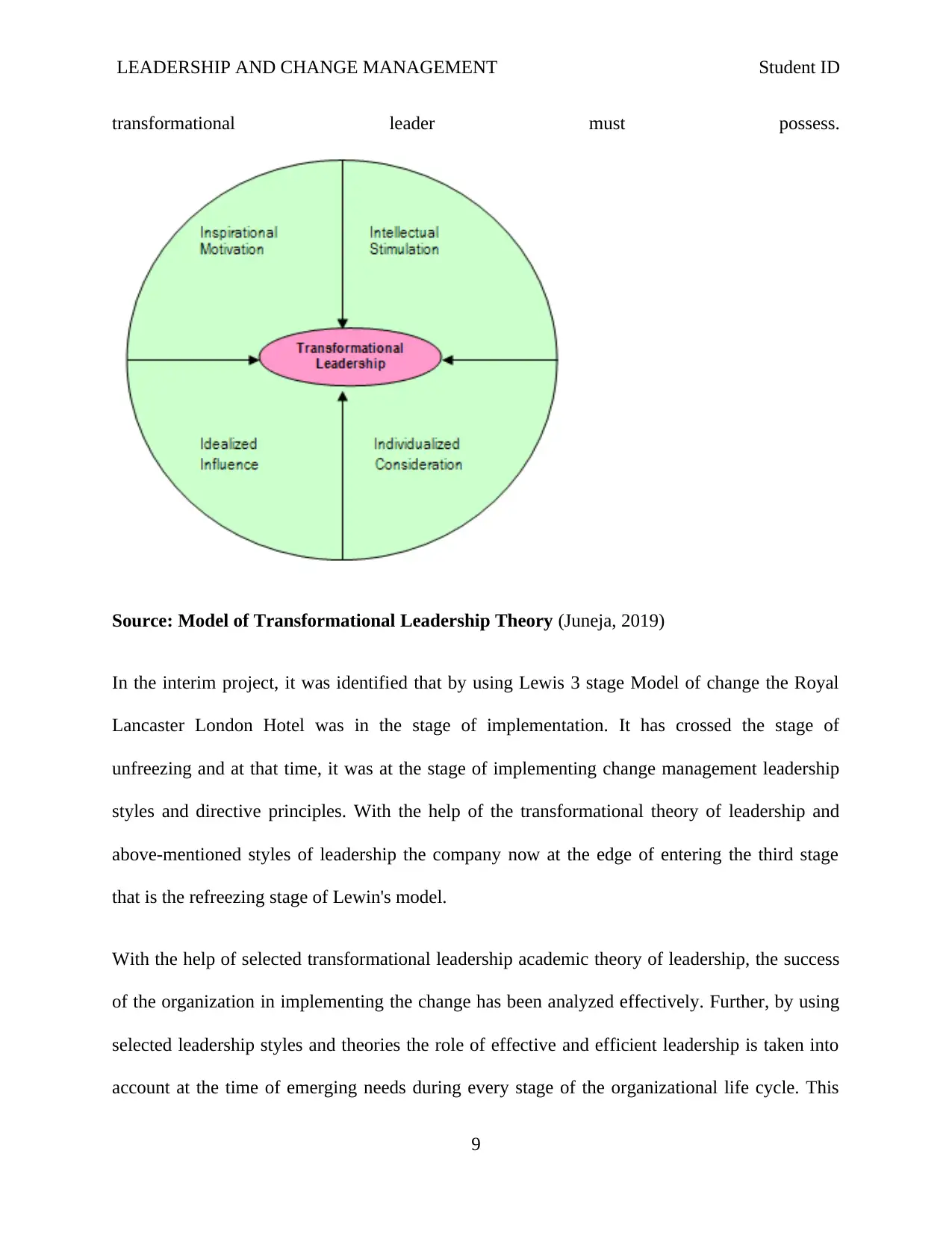
LEADERSHIP AND CHANGE MANAGEMENT Student ID
transformational leader must possess.
Source: Model of Transformational Leadership Theory (Juneja, 2019)
In the interim project, it was identified that by using Lewis 3 stage Model of change the Royal
Lancaster London Hotel was in the stage of implementation. It has crossed the stage of
unfreezing and at that time, it was at the stage of implementing change management leadership
styles and directive principles. With the help of the transformational theory of leadership and
above-mentioned styles of leadership the company now at the edge of entering the third stage
that is the refreezing stage of Lewin's model.
With the help of selected transformational leadership academic theory of leadership, the success
of the organization in implementing the change has been analyzed effectively. Further, by using
selected leadership styles and theories the role of effective and efficient leadership is taken into
account at the time of emerging needs during every stage of the organizational life cycle. This
9
transformational leader must possess.
Source: Model of Transformational Leadership Theory (Juneja, 2019)
In the interim project, it was identified that by using Lewis 3 stage Model of change the Royal
Lancaster London Hotel was in the stage of implementation. It has crossed the stage of
unfreezing and at that time, it was at the stage of implementing change management leadership
styles and directive principles. With the help of the transformational theory of leadership and
above-mentioned styles of leadership the company now at the edge of entering the third stage
that is the refreezing stage of Lewin's model.
With the help of selected transformational leadership academic theory of leadership, the success
of the organization in implementing the change has been analyzed effectively. Further, by using
selected leadership styles and theories the role of effective and efficient leadership is taken into
account at the time of emerging needs during every stage of the organizational life cycle. This
9
⊘ This is a preview!⊘
Do you want full access?
Subscribe today to unlock all pages.

Trusted by 1+ million students worldwide
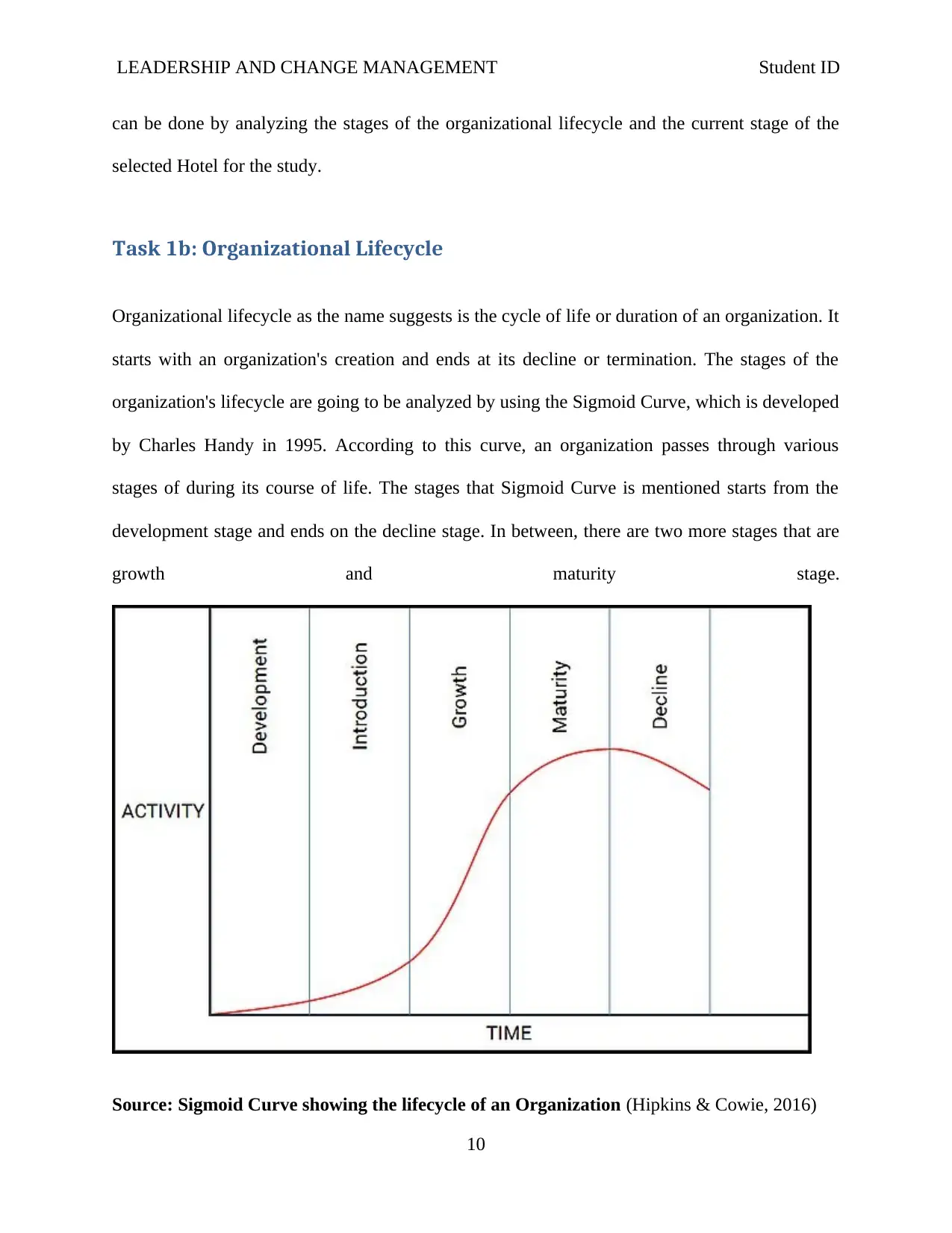
LEADERSHIP AND CHANGE MANAGEMENT Student ID
can be done by analyzing the stages of the organizational lifecycle and the current stage of the
selected Hotel for the study.
Task 1b: Organizational Lifecycle
Organizational lifecycle as the name suggests is the cycle of life or duration of an organization. It
starts with an organization's creation and ends at its decline or termination. The stages of the
organization's lifecycle are going to be analyzed by using the Sigmoid Curve, which is developed
by Charles Handy in 1995. According to this curve, an organization passes through various
stages of during its course of life. The stages that Sigmoid Curve is mentioned starts from the
development stage and ends on the decline stage. In between, there are two more stages that are
growth and maturity stage.
Source: Sigmoid Curve showing the lifecycle of an Organization (Hipkins & Cowie, 2016)
10
can be done by analyzing the stages of the organizational lifecycle and the current stage of the
selected Hotel for the study.
Task 1b: Organizational Lifecycle
Organizational lifecycle as the name suggests is the cycle of life or duration of an organization. It
starts with an organization's creation and ends at its decline or termination. The stages of the
organization's lifecycle are going to be analyzed by using the Sigmoid Curve, which is developed
by Charles Handy in 1995. According to this curve, an organization passes through various
stages of during its course of life. The stages that Sigmoid Curve is mentioned starts from the
development stage and ends on the decline stage. In between, there are two more stages that are
growth and maturity stage.
Source: Sigmoid Curve showing the lifecycle of an Organization (Hipkins & Cowie, 2016)
10
Paraphrase This Document
Need a fresh take? Get an instant paraphrase of this document with our AI Paraphraser
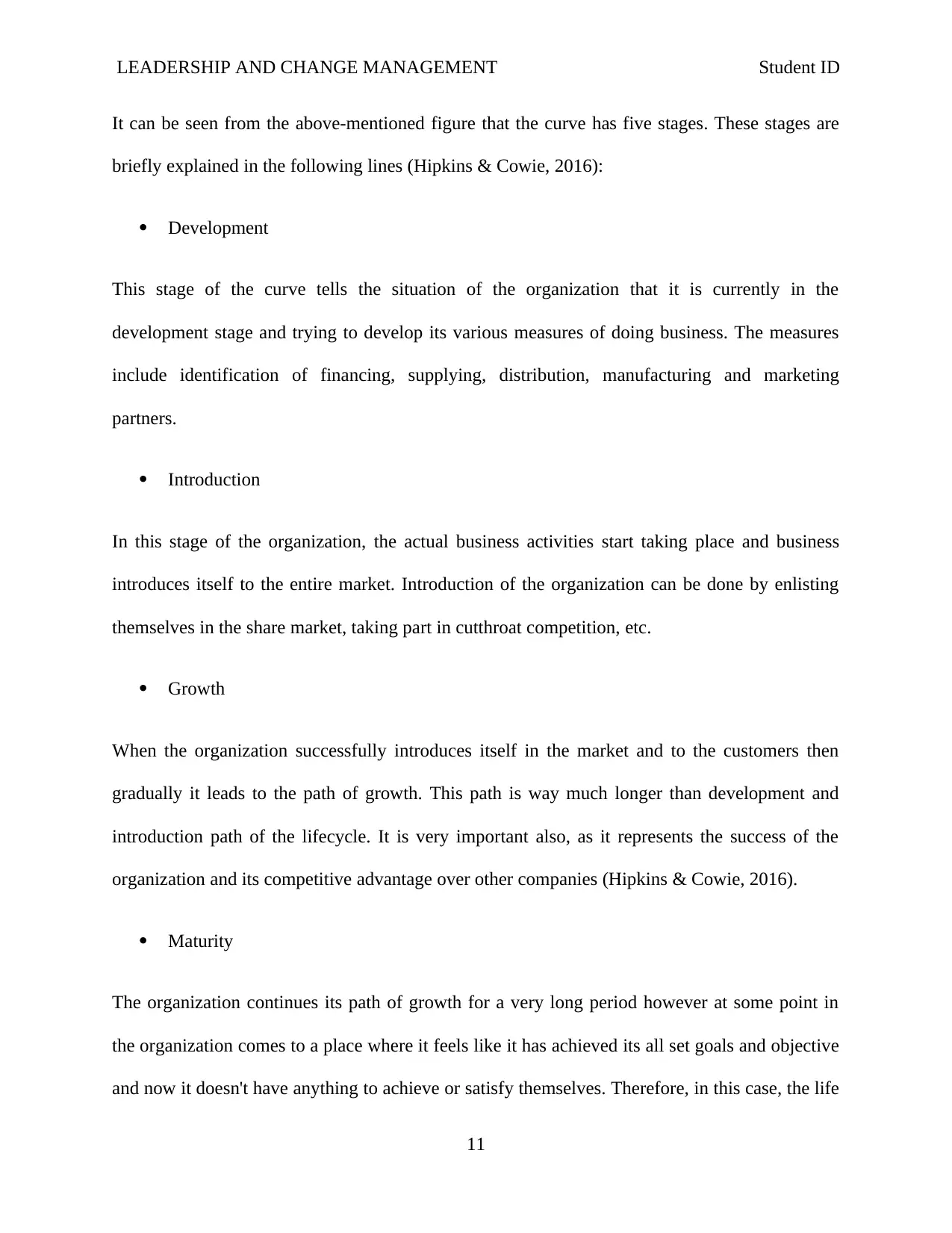
LEADERSHIP AND CHANGE MANAGEMENT Student ID
It can be seen from the above-mentioned figure that the curve has five stages. These stages are
briefly explained in the following lines (Hipkins & Cowie, 2016):
Development
This stage of the curve tells the situation of the organization that it is currently in the
development stage and trying to develop its various measures of doing business. The measures
include identification of financing, supplying, distribution, manufacturing and marketing
partners.
Introduction
In this stage of the organization, the actual business activities start taking place and business
introduces itself to the entire market. Introduction of the organization can be done by enlisting
themselves in the share market, taking part in cutthroat competition, etc.
Growth
When the organization successfully introduces itself in the market and to the customers then
gradually it leads to the path of growth. This path is way much longer than development and
introduction path of the lifecycle. It is very important also, as it represents the success of the
organization and its competitive advantage over other companies (Hipkins & Cowie, 2016).
Maturity
The organization continues its path of growth for a very long period however at some point in
the organization comes to a place where it feels like it has achieved its all set goals and objective
and now it doesn't have anything to achieve or satisfy themselves. Therefore, in this case, the life
11
It can be seen from the above-mentioned figure that the curve has five stages. These stages are
briefly explained in the following lines (Hipkins & Cowie, 2016):
Development
This stage of the curve tells the situation of the organization that it is currently in the
development stage and trying to develop its various measures of doing business. The measures
include identification of financing, supplying, distribution, manufacturing and marketing
partners.
Introduction
In this stage of the organization, the actual business activities start taking place and business
introduces itself to the entire market. Introduction of the organization can be done by enlisting
themselves in the share market, taking part in cutthroat competition, etc.
Growth
When the organization successfully introduces itself in the market and to the customers then
gradually it leads to the path of growth. This path is way much longer than development and
introduction path of the lifecycle. It is very important also, as it represents the success of the
organization and its competitive advantage over other companies (Hipkins & Cowie, 2016).
Maturity
The organization continues its path of growth for a very long period however at some point in
the organization comes to a place where it feels like it has achieved its all set goals and objective
and now it doesn't have anything to achieve or satisfy themselves. Therefore, in this case, the life
11
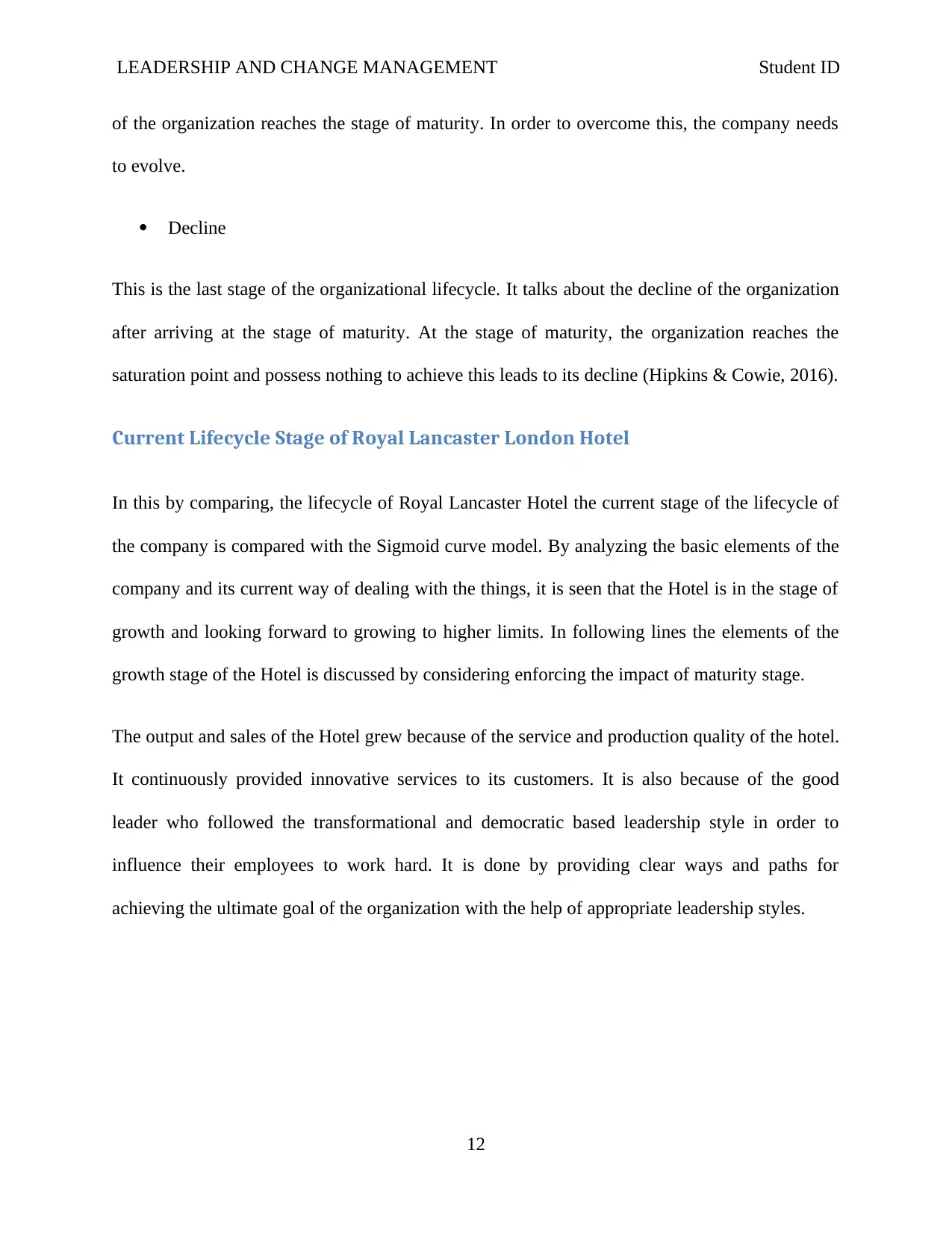
LEADERSHIP AND CHANGE MANAGEMENT Student ID
of the organization reaches the stage of maturity. In order to overcome this, the company needs
to evolve.
Decline
This is the last stage of the organizational lifecycle. It talks about the decline of the organization
after arriving at the stage of maturity. At the stage of maturity, the organization reaches the
saturation point and possess nothing to achieve this leads to its decline (Hipkins & Cowie, 2016).
Current Lifecycle Stage of Royal Lancaster London Hotel
In this by comparing, the lifecycle of Royal Lancaster Hotel the current stage of the lifecycle of
the company is compared with the Sigmoid curve model. By analyzing the basic elements of the
company and its current way of dealing with the things, it is seen that the Hotel is in the stage of
growth and looking forward to growing to higher limits. In following lines the elements of the
growth stage of the Hotel is discussed by considering enforcing the impact of maturity stage.
The output and sales of the Hotel grew because of the service and production quality of the hotel.
It continuously provided innovative services to its customers. It is also because of the good
leader who followed the transformational and democratic based leadership style in order to
influence their employees to work hard. It is done by providing clear ways and paths for
achieving the ultimate goal of the organization with the help of appropriate leadership styles.
12
of the organization reaches the stage of maturity. In order to overcome this, the company needs
to evolve.
Decline
This is the last stage of the organizational lifecycle. It talks about the decline of the organization
after arriving at the stage of maturity. At the stage of maturity, the organization reaches the
saturation point and possess nothing to achieve this leads to its decline (Hipkins & Cowie, 2016).
Current Lifecycle Stage of Royal Lancaster London Hotel
In this by comparing, the lifecycle of Royal Lancaster Hotel the current stage of the lifecycle of
the company is compared with the Sigmoid curve model. By analyzing the basic elements of the
company and its current way of dealing with the things, it is seen that the Hotel is in the stage of
growth and looking forward to growing to higher limits. In following lines the elements of the
growth stage of the Hotel is discussed by considering enforcing the impact of maturity stage.
The output and sales of the Hotel grew because of the service and production quality of the hotel.
It continuously provided innovative services to its customers. It is also because of the good
leader who followed the transformational and democratic based leadership style in order to
influence their employees to work hard. It is done by providing clear ways and paths for
achieving the ultimate goal of the organization with the help of appropriate leadership styles.
12
⊘ This is a preview!⊘
Do you want full access?
Subscribe today to unlock all pages.

Trusted by 1+ million students worldwide
1 out of 23
Related Documents
Your All-in-One AI-Powered Toolkit for Academic Success.
+13062052269
info@desklib.com
Available 24*7 on WhatsApp / Email
![[object Object]](/_next/static/media/star-bottom.7253800d.svg)
Unlock your academic potential
Copyright © 2020–2025 A2Z Services. All Rights Reserved. Developed and managed by ZUCOL.




